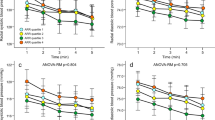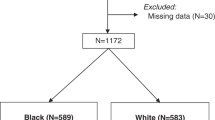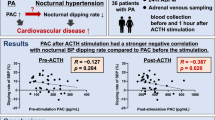Abstract
Exogenous estrogens and progestins may affect the components of the renin–angiotensin–aldosterone system (RAAS). Changes in ventricular blood volume are associated with increased secretion of N-terminal pro-hormone B-type natriuretic peptide (NT-proBNP), which may also be affected by hormonal contraceptives. In this study, we aimed to compare components of the RAAS and NT-proBNP between groups using different hormonal contraceptives, including the combination pill, the injection or implant, and controls (no contraception) in black and white women of fertile age (20 – 30 years). Secondly, we determined whether blood pressure and NT-proBNP are associated with the RAAS components. We included 397 black and white women not using contraceptives, 120 using the combination pill, and 103 receiving an injection/implant. RAAS Triple-A analysis was carried out with LC-MS/MS quantification, and blood pressure measurements (ABPM) taken over 24 h. We found that serum aldosterone was higher (475.7 vs. 249.2 pmol/L; p < 0.001) in the combination pill group than in the no contraception group of white women. The aldosterone-angiotensin II ratio (AA2) was higher (5.4 vs. 2.5; p < 0.001) in the combination pill group than in the no contraception group. In the black women using the combination pill, we found a borderline-positive and borderline-negative association between 24-h systolic blood pressure and NT-proBNP with equilibrium (eq) Ang II, respectively. In white women using the combination pill, only CRP contributed positively and independently to NT-proBNP. To conclude, activation of RAAS by different hormonal contraceptives may increase future risk for the development of hypertension in young black and white women.
This is a preview of subscription content, access via your institution
Access options
Subscribe to this journal
Receive 12 digital issues and online access to articles
$119.00 per year
only $9.92 per issue
Buy this article
- Purchase on Springer Link
- Instant access to full article PDF
Prices may be subject to local taxes which are calculated during checkout

Similar content being viewed by others
References
Chersich MF, Wabiri N, Risher K, Shisana O, Celentano D, Rehle T, et al. Contraception coverage and methods used among women in South Africa: a national household survey. S Afr Med J. 2017;107:307–14.
Stephenson R, Beke A, Tshibangu D. Community and health facility influences on contraceptive method choice in the Eastern Cape, South Africa. Int Fam Plan Perspect. 2008;34:62–70.
Kaida A, Laher F, Strathdee SA, Money D, Janssen PA, Hogg RS, et al. Contraceptive use and method preference among women in Soweto, South Africa: the influence expanding access HIV care treat service. PLoS ONE. 2010;5:e13868. November
Contraception. Human reproduction programme (HRP), World Health Organization, WHO/RHR/14.07_eng. [Accessed 2020, Apr.]
United Nations, Department of Economic and Social Affairs, Population Division. World Family Planning. 2017 - Highlights (ST/ESA/SER.A/414). [Accessed 2020, March].
Woods JW. Oral contraceptives and hypertension. Hypertension 1988;11:11–15.
Ribeiro CCM, Shimo AKK, de M, Lopes MHB, Lamas JLT. Effect of different hormonal contraceptives in women’s blood pressure values. Rev Bras Enferm [Internet]. 2018;71:1453–9.
Harvey RE, Hart EC, Charkoudian N, Curry TB, Carter JR, Fu Q, et al. Oral contraceptive use, muscle sympathetic nerve activity, and systemic hemodynamics in young women. Hypertension. 2015;66:590–7.
Ahmed AH, Gordon RD, Taylor PJ, Ward G, Pimenta E, Stowasser M. Effects of contraceptives on aldosterone/renin ratio may vary according to the components of contraceptive, renin assay method, and possibly route of administration. J Clin Endocrinol Metab. 2011;96:1797–804.
Lam CS, Cheng S, Choong K, Larson MG, Murabito JM, Newton-Cheh C, et al. Influence of sex and hormone status on circulating natriuretic peptides. J Am Coll Cardiol. 2011;58:618–26.
Baughman KL. B-Type natriuretic peptide – a window to the heart. N. Engl J Med. 2002;347:158–9.
Rayner BL, Spence D. Hypertension in blacks: insights from Africa. J Hypertens. 2017;35:234–9.
du Toit WL, Schutte AE, Gafane-Matemane LF, Kruger R, Mels CMC. The renin-angiotensin-system and left ventricular mass in young adults: the African-PREDICT study. Blood Pressure. 2020;30:98–107. https://doi.org/10.1080/08037051.2020.1831902.
Schutte AE, Gona PN, Delles C, Uys AS, Burger A, Mels CM, et al. The African prospective study on the early detection and Identification of cardiovascular disease and hypertension (African-PREDICT, Design, recruitment and initial examination. Europ J of Prevent Cardiol. 2019;26:458–70.
Department of health, Pretoria, South Africa. National contraception clinical guidelines. 2012. www.doh.gov.za. [Accessed 2020, Nov.]
Marfell-Jones M, Olds T, Stewart A, Carter L. International standards for anthropometric assessment. International Society for the Advancement of Kinanthropometry; 2006. p. 137.
Patro BK, Jeyashree K, Gupta PK. Kuppuswam’s Socioeconomic Status Scale 2010 – the need for periodic revision. Indian J Pediatr. 2012;79:395–6.
Hayashi I, Morishita Y, Imai K, Nakamura M, Nakachi K, Hayashi T. High-throughput spectrophotometric assay of reactive oxygen species in serum. Mutat Res. 2007;631:55–61.
Odutayo A, Cherney D, Miller J, Ahmed SB, Lai V, Dunn S, et al. Transdermal contraception and the renin-angiotensin-aldosterone system in premenopausal women. Am J Physiol Ren Physiol. 2015;308:F535–40.
Burrello J, Gai C, Tetti M, Lopatina T, Deregibus MC, Veglio F, et al. Characterization and gene expression analysis of serum derived extracellular vesicles in primary aldosteronism. Hypertension 2019;74:359–67.
Stowasser M, Ahmed A, Guo Z, Wolley M, Ungerer J, McWhinney B, et al. Can screening and confirmatory testing in the management of patients with primary aldosteronism be improved? Horm Metab Res. 2017;49:915–21.
Van Rooyen JM, Poglitsch M, Huisman HW, Gafane-Matemane LF, Breet Y, Malan L. A primary aldosteronism-like phenotype identified with the aldosterone-to-angiotensin II ratio in black men: the SABPA study. Cardiovasc J Afr. 2019;30:1–6.
Kuroski de Bold ML. Estrogen, natriuretic peptides and the renin-angiotensin system. Cardiovasc Res. 1999;41:524–31.
Lee CYW, Burnett JC. Natriuretic peptides and therapeutic applications. Heart Fail Rev. 2007;12:131–42.
Divani AA, Luo X, Datta YH, Flaherty JD, Panoskaltsis-Mortari A. Effect of oral and vaginal hormonal contraceptives on inflammatory blood biomarkers. Mediators Inflamm. 2015;2015:379501.
Acknowledgements
We thank the participants in this substudy, as well as the staff who participated in collecting the data.
Funding
This work is supported by the South African Medical Research Council (SAMRC) with funds from the National Treasury under its Economic Competitiveness and Support Package; the South African Research Chairs Initiative (SARChI) of the Department of Science and Technology and National Research Foundation (NRF) of South Africa; the SAMRC with funds received from the South African National Department of Health, GlaxoSmithKline R&D (Africa Non-Communicable Disease Open Lab grant); the UK Medical Research Council and with funds from the UK Government’s Newton Fund; as well as the corporate social investment grants from Pfizer (South Africa); Boehringer Ingelheim (South Africa); Novartis (South Africa); the MediClinic Hospital Group (South Africa); and in-kind contributions from Roche Diagnostics (South Africa). Any opinion, findings, and conclusions or recommendations expressed in this material are those of the authors, and therefore, the National Research Foundation (NRF) does not accept any liability in this regard.
Author information
Authors and Affiliations
Corresponding author
Ethics declarations
Competing interests
Dr M Poglitsch has stocks in Attoquant Diagnostics GmbH.
Additional information
Publisher’s note Springer Nature remains neutral with regard to jurisdictional claims in published maps and institutional affiliations.
Supplementary information
Rights and permissions
About this article
Cite this article
van Rooyen, J.M., Poglitsch, M., Mels, C.M.C. et al. Aldosterone and angiotensin II profiles in young black and white women using different hormonal contraceptives: the African-PREDICT study. J Hum Hypertens 36, 711–717 (2022). https://doi.org/10.1038/s41371-021-00569-6
Received:
Revised:
Accepted:
Published:
Issue Date:
DOI: https://doi.org/10.1038/s41371-021-00569-6



